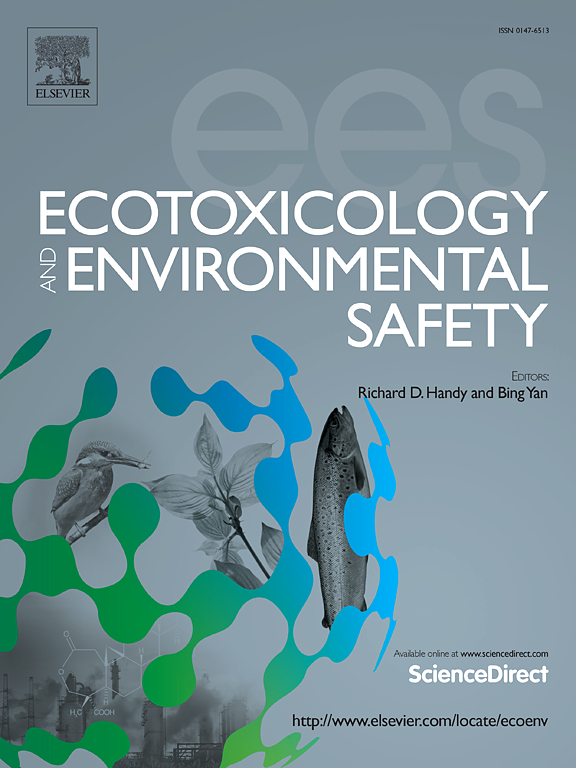自身免疫性脑炎患者血清和脑脊液中内分泌干扰化学物质的筛选
IF 6.2
2区 环境科学与生态学
Q1 ENVIRONMENTAL SCIENCES
引用次数: 0
摘要
人类暴露于各种内分泌干扰化学物质(EDCs),如有机磷酸酯(OPEs)和邻苯二甲酸酯(PAE)代谢物。虽然EDCs可以穿过血脑脊液屏障(BCSFB)到达大脑,但它们对自身免疫性脑炎(AE)的影响尚不清楚。因此,EDC暴露与AE之间的关系被确定。该研究招募了106例AE患者和119例无AE患者。使用配对的血清- csf样本,我们量化了17种EDCs的8类。通过计算血脑屏障(BBB)指数和配对血清-脑脊液浓度比两项指标评价部分EDCs的穿透性。此外,我们通过条件逻辑回归分析调查了EDC暴露与AE的关系。在EDC的∑8类别中,抗氧化剂、PAE代谢物和OPEs是最主要的EDC。中位EDC比值(REDC = EDCCSF/EDC血清)范围为对羟基苯甲酸甲酯(MeP)的0.040 %至对羟基苯甲酸乙酯(EtP)的3.808 %。AE患者更容易出现血脑屏障破坏。发现AE与某些EDCs之间存在关联。例如,血清EtP和对羟基苯甲酸丁酯(BuP)水平[优势比(OR) = 1.69;95 %置信区间(CI): 1.25, 2.27;或= 1.51;95 % CI: 1.14, 2.00)和CSF MeP水平(OR =1.54;95 % CI: 1.30, 1.84)均与AE风险增加相关。我们发现暴露于某些环境中的EDCs可能是AE发展的一个危险因素。我们的发现为特定化学物质可能损害神经功能的影响提供了证据基础。本文章由计算机程序翻译,如有差异,请以英文原文为准。
Screening for endocrine-disrupting chemicals in the serum and cerebrospinal fluid of patients with autoimmune encephalitis
Humans are exposed to a variety of endocrine-disrupting chemicals (EDCs), such as organophosphate esters (OPEs) and phthalate ester (PAE) metabolites. Although EDCs can cross the blood-cerebrospinal fluid barrier (BCSFB) to the brain, their effects on autoimmune encephalitis (AE) remain unclear. Therefore, the association between EDC exposure and AE were determined. The study recruited 106 patients with AE and 119 patients without AE. Using paired serum-CSF samples, we quantified 8 categories of 17 EDCs. The penetration of some EDCs was evaluated through two indices: calculated the blood-brain barrier (BBB) index and the paired serum-CSF concentration ratio. Further, we investigated the association of EDC exposure with AE by the conditional logistic regression analysis. Antioxidants, PAE metabolites, and OPEs were identified as the most dominant EDC in the ∑8 categories of EDCs. The median EDC ratios (REDC = EDCCSF/EDCSerum) ranged from 0.040 % for methyl paraben (MeP) to 3.808 % for ethyl paraben (EtP). AE patients are more likely to have BBB disruption. The associations between AE and some EDCs were found. For example, serum EtP and butyl paraben (BuP) levels [Odds Ratio (OR) = 1.69; 95 % confidence interval (CI): 1.25, 2.27; OR = 1.51; 95 % CI: 1.14, 2.00), and CSF MeP levels (OR =1.54; 95 % CI: 1.30, 1.84) were both associated with an increased risk of AE. We identified that exposure to certain environmental EDCs may be a risk factor for the development of AE. Our findings support an evidence base for the effects of specific chemicals may impair neural functions.
求助全文
通过发布文献求助,成功后即可免费获取论文全文。
去求助
来源期刊
CiteScore
12.10
自引率
5.90%
发文量
1234
审稿时长
88 days
期刊介绍:
Ecotoxicology and Environmental Safety is a multi-disciplinary journal that focuses on understanding the exposure and effects of environmental contamination on organisms including human health. The scope of the journal covers three main themes. The topics within these themes, indicated below, include (but are not limited to) the following: Ecotoxicology、Environmental Chemistry、Environmental Safety etc.

 求助内容:
求助内容: 应助结果提醒方式:
应助结果提醒方式:


